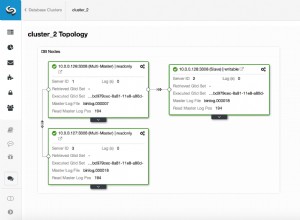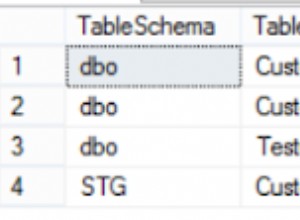Jeśli nie chcesz używać płynnej składni, istnieją trzy inne sposoby implementacji odniesienia za pomocą adnotacji danych (osobiście wolę adnotacje danych, ponieważ wydają się łatwiejsze do odczytania i są napisane tuż nad właściwością, na którą wpływają):
1.1) Użyj klucza obcego (z powiązaną właściwością) - wersja 1
[Table("WIDGETENTITIES")]
public class WidgetEntity {
[Column("WIDGETENTITY_ID")]
public int Id { get; set; }
[Column("WIDGETSEQUENCE_ID")]
public int WidgetSequenceId { get; set; }
[ForeignKey("WidgetSequenceId")] //Has to be a property name, not table column name
public WidgetSequence Sequence { get; set; }
// and other properties that map correctly
}
[Table("WIDGETSEQUENCES")]
public class WidgetSequence {
[Column("WIDGETSEQUENCE_ID")]
public int Id { get; set; }
[Column("NUMBER")]
public int Number { get; set; }
}
1.2) Użyj klucza obcego (z powiązaną właściwością) - wersja 2
[Table("WIDGETENTITIES")]
public class WidgetEntity {
[Column("WIDGETENTITY_ID")]
public int Id { get; set; }
[ForeignKey("Sequence")] //Has to be a property name, not table column name
[Column("WIDGETSEQUENCE_ID")]
public int WidgetSequenceId { get; set; }
public WidgetSequence Sequence { get; set; }
// and other properties that map correctly
}
[Table("WIDGETSEQUENCES")]
public class WidgetSequence {
[Column("WIDGETSEQUENCE_ID")]
public int Id { get; set; }
[Column("NUMBER")]
public int Number { get; set; }
}
2)Możesz również użyć atrybutu InversePropertyAttribute.
[Table("WIDGETENTITIES")]
public class WidgetEntity {
[Column("WIDGETENTITY_ID")]
public int Id { get; set; }
[InverseProperty("WidgetEntities")]
public WidgetSequence Sequence { get; set; }
// and other properties that map correctly
}
[Table("WIDGETSEQUENCES")]
public class WidgetSequence {
[Column("WIDGETSEQUENCE_ID")]
public int Id { get; set; }
[Column("NUMBER")]
public int Number { get; set; }
public virtual List<WidgetEntity> WidgetEntities { get; set; }
}




